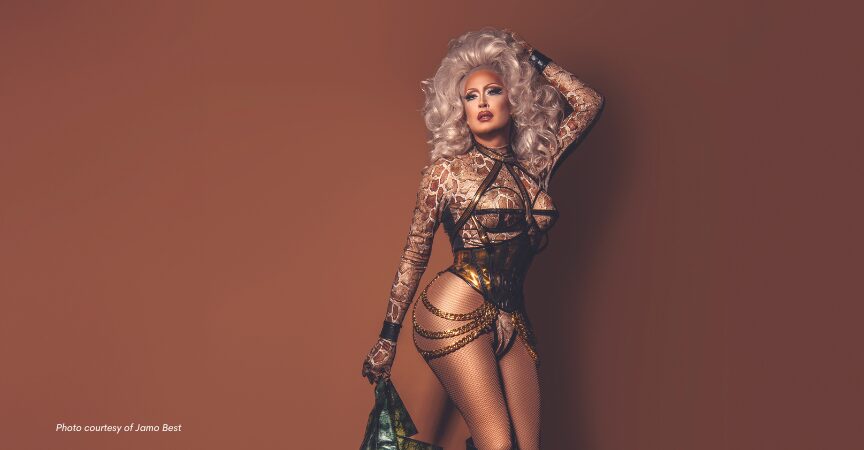Slay the Buffet
MENU IN CONVERSATION WITH: Adam Moco (aka Miss Moço) on the growing allure of Drag Brunch and the ins and outs of putting eatertainment on the menu.
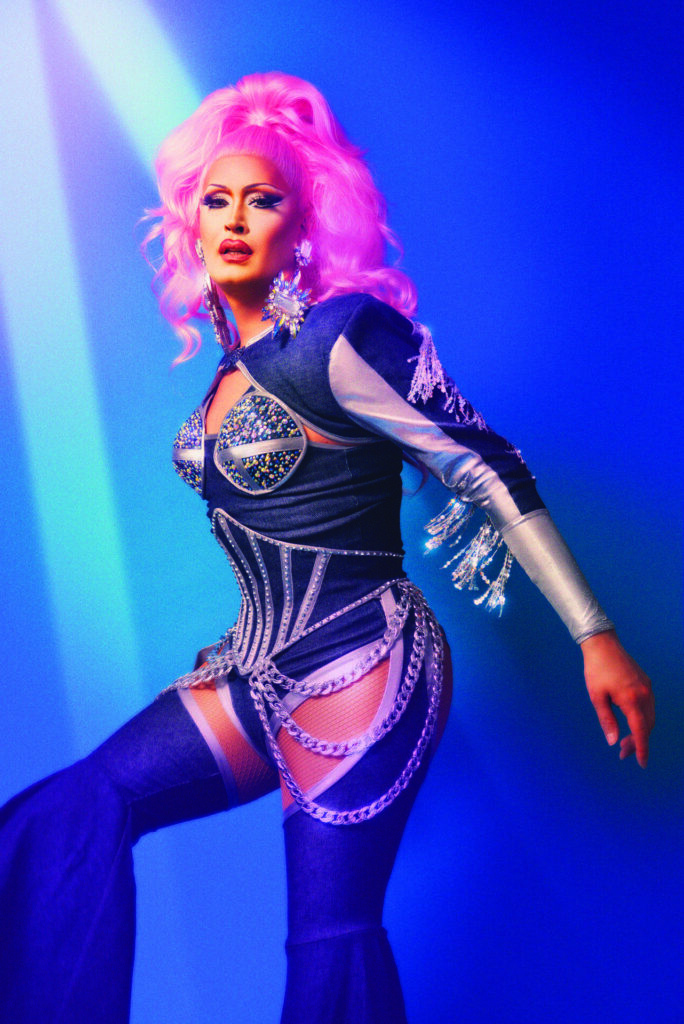
In the tapestry of performing arts, drag stands out as a vibrant thread, weaving together humour, fashion and political commentary. It has evolved from ancient roots into a multifaceted art form that celebrates gender fluidity and self-expression, gaining visibility, momentum and popularity with television shows like RuPaul’s Drag Race.
No longer confined to theatres, screens and nightclubs, drag has been popping up in broad daylight with a side of bacon to rescue the wilting weekend brunch service. As restaurants grapple with fluctuating attendance, operators are looking for new ways to spice up their offerings and attract new audiences. For a growing number of these, drag brunches and other forms of “eatertainment” are successfully pairing the excitement of performance with the pleasure of dining to deliver an
unforgettable and profitable experience.
MENU caught up with Adam Moco, the drag performer otherwise known as Miss Moço, Toronto’s Drag Brunch Queen, to talk about what he’s learned from restaurants and what drag has to offer hospitality.
Photo courtesy of Jamo Best
MM: Have you ever worked in hospitality? We heard a rumour that you used to operate a café…
Adam Moco: I grew up in Cambridge, Ontario, and my first hospitality gig was none other than McDonald’s and, like everything I do in life, I kind of just always want to get to the next level. I started in prep in McDonald’s, and I was like, “Okay, well, I want to be at front cash, which will then get me onto the drive-thru and so on. I just I wanted to know how to do everything in the space to understand how it how it worked.”
I was 16 years old, so I don’t know why I wanted to do that but fast-forward to me now, and I get it. It’s just my personality. I want to be the one who’s managing things and on top of everything.
I ended up opening Miss Pippa’s at College and Dufferin, a café/bar/flower/gift shop—
it’s kind of a mix of everything. It was the brainchild of my now ex-husband, but I took on the role of opening it and getting all the necessary pieces in place, which is not as easy as one would think. I took on dealing with the city, getting permits, fire, health, and the liquor board. By the time I left, we were operating as a kind of casual bar that had gifts and a bunch of things. I feel like these days, people want to be able to have access to everything all at once.
MM: It’s no secret that time spent in early hospitality roles is so foundational for many people in terms of getting your head organized and ready for work. How did that translate into your own experience opening your concept?
AM: I think it taught me a lot about who I am as a person and how I work. I learned that I’m best suited to dipping into multiple things, which is why I went the artist-entrepreneur route in my life as opposed to the nine to five.
Restaurants may be open for very specific hours, but the things you put into it make it feel totally not nine-to-five because you’re dealing with so many different things and I just kind of thrive in those environments. I was 16 and wanted to get out of Cambridge and go to college and live my life, but did it shape me a little bit? Probably. Actually, there’s one thing from that experience I’ve always held on to. In the back during prep there was a screen that had all the orders coming in, and it used a 24-hour clock. I had to learn how to read the 24-hour clock on that thing and since then I’ve always gone by the 24-hour clock. When I moved to Europe, that’s what they do, so it was just one of those weird little things that has helped me along in my life.
MM: I understand you’re also a photographer.
AM: Photography was my first career. I graduated in 2010 and went into it full-time until at the end of 2015, just before New Year’s I moved to Portugal. I had been shooting for Holt Renfrew for about four years and they were switching up to become salary-based whereas I wanted to stay artist-based. I took that as a sign to do what I always wanted to do and moved to Portugal to take a break and work on my art. Drag was part of that and it took over my life.
When I moved back in 2018, the two careers had swapped. Photography took the back seat and drag took the front seat. For the past almost nine years, drag has been my main gig.
MM: What initially attracted you to drag? As an art form before it was a business.
AM: One of the first shows I saw was in Miami. It was a drag brunch, and seeing the restaurant with the entertainment mixed together to create this incredible atmosphere stuck with me. I was already living a world where I was not following gender norms. I eased my way into it when, in 2015, someone asked me if I wanted to pose for a poster wearing a wig for an event. I said, “Sure. Can I perform?” I just plopped myself on a stage and I was kind of just born that night.
When I returned to Toronto in 2018, I based my entire career on drag brunch, and I’m known as the Drag Brunch Queen. When people saw how successful my drag brunches became, they wanted me for theirs, which is a challenge. These two worlds that didn’t really exist in the city have really exploded into so many restaurants having drag brunches.
MM: Would you do a second Drag Brunch? What would an optimal restaurant to host the event look like?
AM: I did actually do a second, monthly Drag Brunch at Soho House, which is a member’s club, so there was no competition there.
I’ve done quite a few drag brunches in my career now. There are so many pieces involved to consider. There’s the entertainment itself, and the entertainer also needs to know how to work a space that’s not a standalone stage. You’re working the room, you’re working people individually and you’re also keeping an eye on servers coming through with plates of food and making sure you’re not running into them.
The key is that people want to come, they want to sit down, enjoy a show, eat and drink as if they were just going out for a regular meal, but with this added extra layer of entertainment. That excitement, in turn, makes guests want to purchase more, which benefits the restaurant. We’re two teams working together. I’m working for people to book and come to this drag brunch, and making sure the quality of the entertainment benefits the restaurant’s profits.
MM: What kind of space is most appropriate for a drag brunch or similar interactive event and what opportunity or dimension does it add?
AM: If you compare a restaurant to a venue space where there’s just a stage that’s four feet higher than everyone in the crowd, there’s a disconnect between the artist and the audience. In a restaurant, the audience is physically on the same level.
At my Brunch, I go to every table and say hi, welcome people and find out if they’re celebrating a specific occasion to build those connections with the audience. I think this is a huge reason I’ve been doing this for so long and why people keep coming back. People feel like they are a part of the show as opposed to just watching it happen.
When it comes to the food… food is such a comfort to begin with. To sit and feel comfortable with your plate of food and your drinks and then to have entertainment that is acknowledging you at the same time makes it a safe, comfortable space for people. That’s what makes them want to come back or tell a friend.
I do have regulars, but there’s weeks in between. I normally ask who’s a first timer at Drag Brunch at The Drake Hotel and it’s usually at least 90 per cent of the room with their hands up. That makes me really excited to know that it’s reaching a broader audience and that means people are going to be more willing to spend money because they’re not coming every week. We love a regular, but we don’t want anyone thinking, “Okay, I was here just last week, so I’m not going to go too wild.” We want to be reaching audiences we haven’t been before and just keep capturing that every single week. So that’s what I’ve been trying to do and it’s working. Don’t ask me how, but it just works.
MM: So, what you’re essentially saying is that the special occasion aspect of the entertainment has a direct effect on cheque size because guests have different motivations for showing up and possibly different expectations. With such established success, do you consider The Drake your local?
AM: Yeah, I also started my Drag Brunch at the Gladstone Hotel in 2018. So that was November 2018. I was there until the pandemic hit, and then we were off while it was purchased and renovated. By the time they were ready to open, I got on Canada’s Drag Race, and was leaving for about a month and a half, so I couldn’t start back up. I came back in May of 2022 and started with The Drake, and I don’t see an end in sight. It’s my primary gig. We all love a little bit of routine, and mine is my Drag Brunch every Saturday no matter what. It gives me something to look forward to each week.
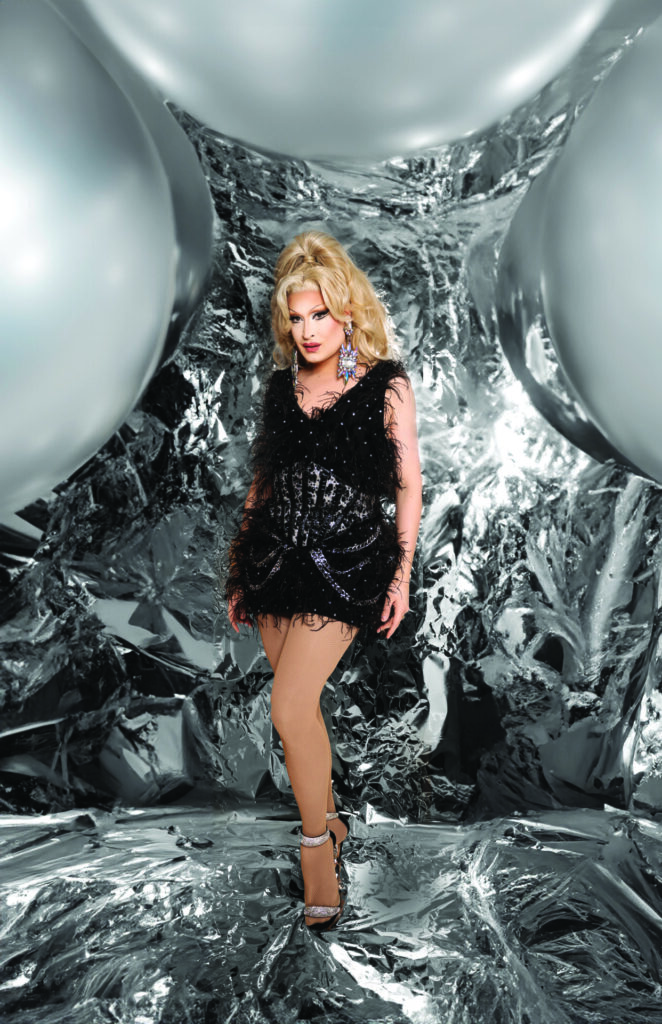
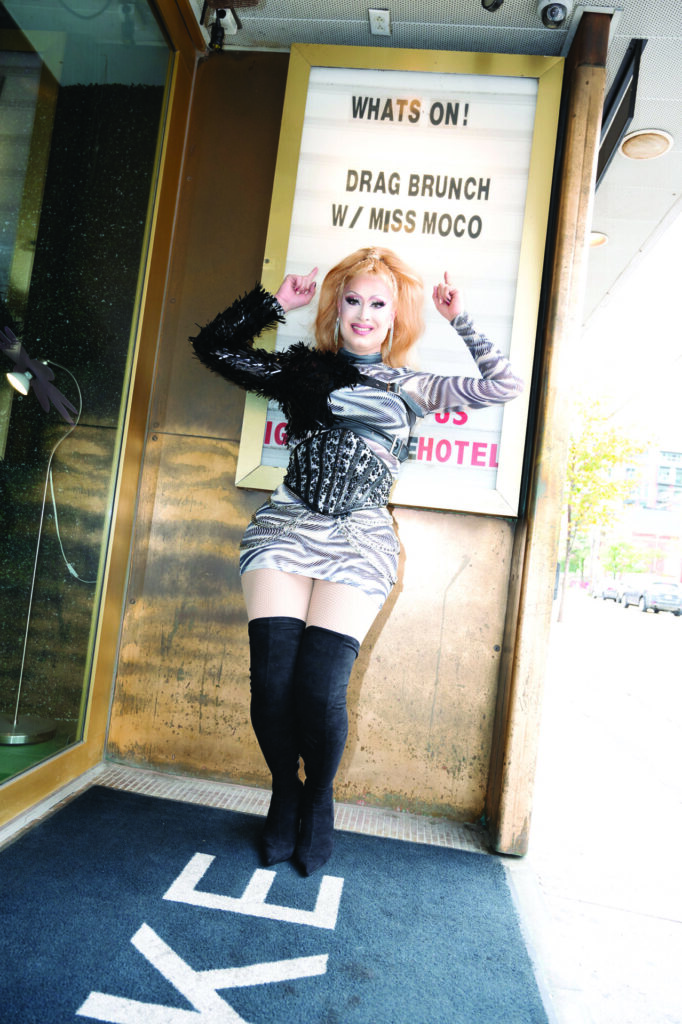
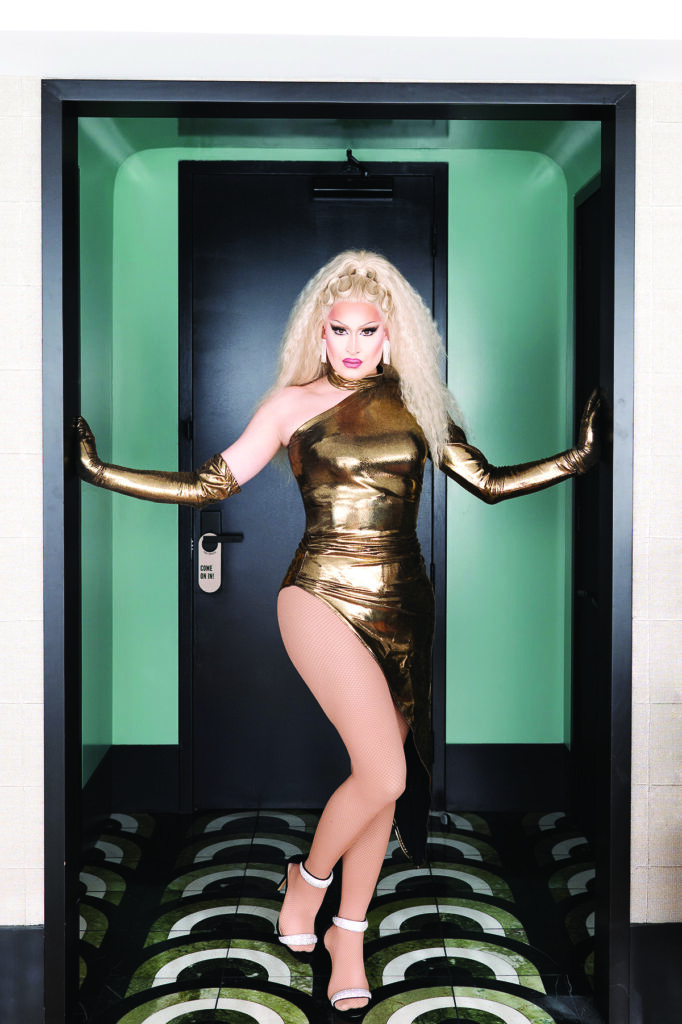
MM: Drag is a lot, from a performance perspective. How challenging is it to put on that level of performance weekly?
AM: I do take it very seriously, to the point where Friday nights I’m in bed 10-10:30 and up at six or six-thirty on Saturday mornings. If there is a gig on a Friday, it has to really be worth it for me to only get three or four hours of sleep.
The preparation isn’t just getting ready that morning, it’s packing what I want to wear for Brunch the night before. I make sure I’m keeping things different. I had someone come to Brunch this past weekend and it was her third time. In my Brunch, I have three different outfits for the different sets I do, so that means she has seen me in nine different outfits. She said there were no repeats, and to me that was wild because there’s often times I love a look so much I will wear it a few times—just because I’m really into it.
Hearing that reminds me of why I put so much effort into preparation, figuring out which wig, which outfit, which shoes to really pull it all together and waking up so early to really enjoy the process. I don’t ever want to see it as “Ugh…not again”, because doing your makeup is not the most exciting thing, especially so early on a Saturday. I make sure I put my heart and soul into it because I love it so much.
MM: You studied fashion, did you not? Do you design any of your outfits?
AM: I did Fashion Business at George Brown College. The funny thing is that I know how to sew, but I got on Drag Race and almost went home because of the sewing challenge. I made an outfit recently because I didn’t have anything I wanted. I was doing an Emo brunch, so I made this plaid bodysuit with a sort of skirt situation.
I plan to do more sewing and design now that I have a studio and more space, but primarily I have someone who makes my things.
But… again, like that time at McDonald’s, I had someone walk me through how to style my own wigs so I can do that myself. I want to start making a few of my own staple pieces – just easy, grab-and-go outfits – I always want to learn how to do it all.
MM: What can restaurant operators who are planning to host a drag brunch or similar event do to ensure success and make sure everyone has a great time?
AM: The space should be inviting, the menu has to be exciting. Whether it’s a deal or a special menu that complements the event—for example, one of the drinks at The Drake’s Drag Brunch has my name in it—or they use drag puns; people find that level of theme and detail exciting. That little bit of extra makes a real difference and makes it all make sense.
Throwing a drag queen in the middle of restaurant, especially if that’s never happened there before, can be jarring. You have to be really mindful of how it’s curated, from menu to space to how it’s advertised. It really has to make sense and shouldn’t look like it came from left field.
MM: What can restaurant operators learn from the success of Drag Brunch, and how to approach selecting entertainment or other programming?
AM: Community building is key. Going into the community to connect with people is the biggest thing. By engaging the community, you’re already pretty much guaranteed to bring some numbers in, especially those people who may be possibly looking for a space to perform. Starting there—
especially if you don’t know who to approach—and finding out what’s happening in the community, what’s worked for others and what hasn’t, and what others are already doing is a great place to start. Maybe it’s just a musician with an acoustic guitar—how simple is that? It’s all about just trying to find that other angle.
If you hire talent from the community, you’re halfway there, because those are the people you want to come to your place.
The other thing to consider is that, when places do try something new and especially when drag is involved, there can be pushback from other community members who think, “It’s disgusting!” “Drag queens are grooming the children!” It can be shocking how quickly people who were eager to bring this into their space throw it out because they’re scared by that.
I find generally the ones who throw it out as quick as they brought it in are not really here for those artists to begin with. They’re just thinking about the money. So, if that’s your route, you’re not going to create the long lasting, community based event you’re looking for. You need to go into it with the mindset that there could be pushback, especially with drag, so you need to know that going in and be prepared to stand by the people you’ve hired and want to support . You need to commit to making sure they know they will be safe working in your space. That is so important.
MM: Drag is an art form first, so hosting drag events is effectively a way to support art and performance within the community. Of course, not everyone sees it that way. What has your experience been like with operators who may have had negative feedback?
AM: I’ve been really lucky to not experience it first-hand, too much. I did do a Drag Brunch in Winnipeg and, a couple of weeks before I was going down, there was a drag queen story time at a public library that had a major protest outside. So going in I understood that it could happen, but I thought it would be fine. And up until the end, it was.
The venue had a kind of little event space I was performing in, and the rest of the restaurant was outside that area. They didn’t close us in, so people who were not involved in the Drag Brunch could still see in. When I’d finished the brunch, as I always do, I let everyone know that I was hanging around for a bit in case they wanted to snap some photos just outside the event space at the entrance to the main restaurant. Look, the light from the windows was coming in and I’m a drag queen so I want the good light on my face.
The manager came up to me and said, “Hey, do you mind just staying in here on the stage? There are children out there.”
I was just floored.
MM: What interested you about the opportunity to host Breakfast With Champions next month?
AM: I’m honoured to be hosting Breakfast with Champions. As someone who has been part of the hospitality world for so many years, I understand how much hard work goes into this industry and I’m so pleased to be celebrating and bringing some spice to this event. Also, I’m a brunch queen, my face is painted for daytime!
MM: What’s next in the development of your business? Are you thinking about consulting and growing your concept and sharing your experience?
AM: It’s an important space that isn’t occupied. When I moved back to the city I didn’t want to fight other queens for the night gigs. I wanted to put myself out there and try something new. I make my own events and do my own thing, but this event was one of the ones that really worked for me.
That’s funny you bring that up because that just seems to be something that has entered into my life without me even thinking about it.
I’m currently coaching someone in their world specifically to help their on-stage presence and the idea of consulting is a world that is opening up to me and that I’m considering more and more as a secondary business. I’m already doing so many things, but it’s another avenue for me to find work and explore my art and what I do.
I’m definitely interested in these things, but I’m not sure how it will look. Everyone is so different when it comes to this sort of thing that you have to just kind of craft as you go. It doesn’t matter. I like talking to people. Send me an email, DM me or come and say hello at RC Show.
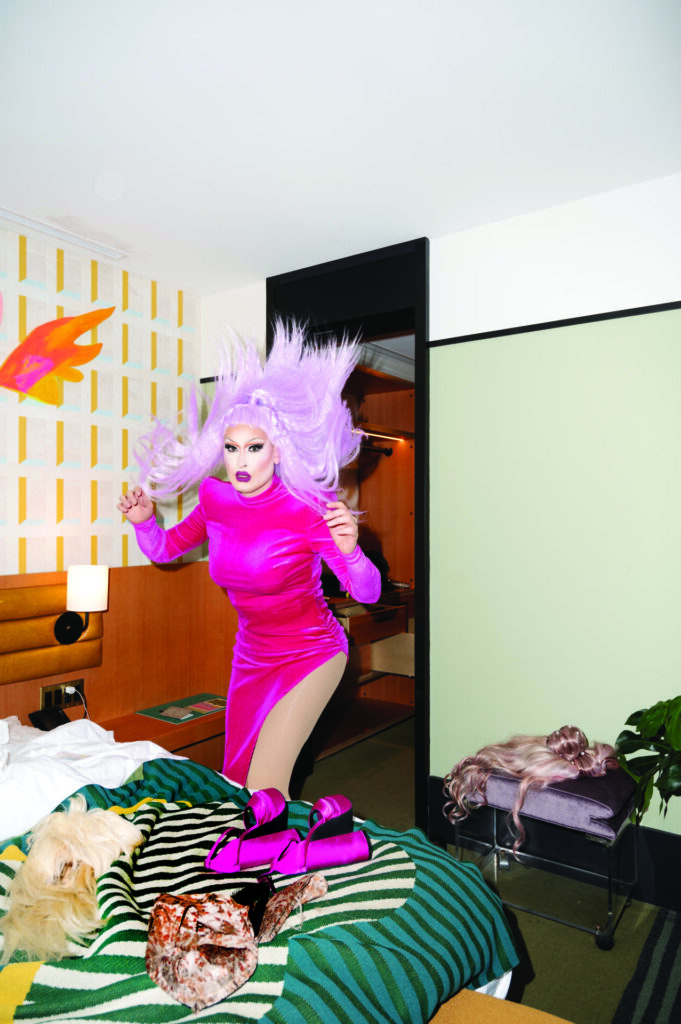
Follow Miss Moço on Instagram: @missmoco



